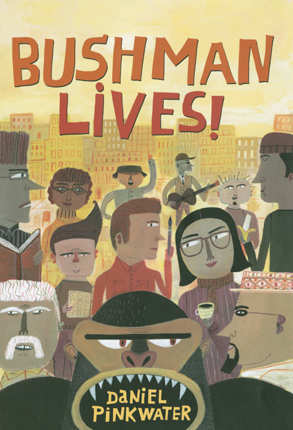Full Text Reviews: Bulletin for the Center... - 11/01/2012 After seeing a painting at Chicago’s Art Institute that leaves him “happy and buzzy,” seventeen-year-old Harold Knishke decides he wants to be an artist. Sure, he’s never really drawn more than stick figures, but that doesn’t stop him; fortunately, the members of the artsy scene of Chicago’s beatnik era seem more than willing to help. Harold begins by taking drawing classes from a taxidermist, then finds a mentor in a muralist who camouflaged entire villages during World War II, sets up a workshop in a translucent mansion, and eventually sets sail for a hidden island in Lake Michigan in search of both a missing gorilla (the titular Bushman) and an artistic adventure. Pinkwater’s trademark wackiness is on full display here, but the amiable absurdity effectively serves a secondary purpose of leavening a treatise on the nature of art with wit and self-referential mockery. Young readers may have a problem immediately identifying and relating to the 1950s beatniks, but the author’s commentary on the gatekeepers of the art world will sit well with those both awed by and suspicious of today’s hipsters. Plenty of teens will recognize the issues that Harold confronts-subjectivity of taste, the lure of selling out-as he tries to figure out what art is. The parade of eccentric characters Harold meets is undeniably entertaining, and the conversations he has with them are often provocative and direct, pondering the reasons and motivation behind creation but in an accessible and often humorous manner. Framing all of this is a love letter to Chicago and Windy City residents, and fans will particularly welcome the inclusion of bits of historical trivia, geographic landmarks, and general appreciation. KQG - Copyright 2012 The Board of Trustees of the University of Illinois. Booklist - 10/15/2012 Let’s face it: Pinkwater is sui generis—there isn’t anyone else quite like him. And if you doubt that, you haven’t read his latest, a book that is almost impossible to synopsize. Suffice it to say, it is a story set in 1950s Chicago of teenager Harold Knishke, who—inspired or perhaps enchanted by a de Kooning painting—decides to ditch his flute lessons and become an artist instead. The result is a bildungsroman as surrealistic romp, involving Harold’s best friend, Geets, whose talent is climbing tall buildings; the famous gorilla Bushman, who may or may not be dead; strange mentors; a spooky, white house; an apocryphal island; and enough coincidences to make Dickens green with envy. The wacky, sometimes bewildering story is told in 79 brief chapters, some no longer than a single page. The prevailing tone is Pinkwateresquely insouciant, and the abrupt ending may leave some readers scratching their heads and others chortling. Clearly not for every reader, but Pinkwater’s many fans will rejoice. - Copyright 2012 Booklist. School Library Journal - 11/01/2012 Gr 7 Up—Much of the humor in Bushman Lives! depends on a fairly high degree of cultural literacy, but its sheer goofiness will captivate reluctant readers. Harold Knishke, 16, plays the flute so badly that his teacher begs him to give up lessons and buys the instrument from him for $50. The teen then has Saturdays free to explore 1960s Chicago. He meets an astounding number of characters, all of whom have life lessons to offer him. The individual who appears to have taught him the most, however, is the eponymous Bushman, a 427-pound gorilla with whom Harold communed as a young boy. Bushman was happy in the zoo and docile enough to play outside his cage, until he decided he didn't want to go back and his keepers thereafter kept him confined. Bushman still managed to live a good life, though conscious of his imprisonment. Harold, conscious of the constraints that society puts on him, learns to move about easily through the power of art (especially abstract-De Kooning and Kandinsky). There are heavy messages, but they are delivered in a style that is part Marx Brothers, part S.J. Perelman, and part Andy Milonakis. The standout secondary characters are Geets Hildebrand, Harold's wall-climbing buddy who brings him Guinness and bananas to toast the dead Bushman; Molly the Dwerg and her not-dog/not-wolf familiar, Wolluf; and Harold's understanding father, who works for the Salami Board. Pinkwater re-creates the era so well-including ubiquitous drinking and smoking-but refers to a suitcase record player as "old-fashioned." It would have been pretty newfangled in 1960. A very minor slip in what is otherwise a great read, this is a paean to the transformative power of art, and vintage Pinkwater.Nina Sachs, Walker Memorial Library, Westbrook, ME - Copyright 2012 Publishers Weekly, Library Journal and/or School Library Journal used with permission. Loading...
|



